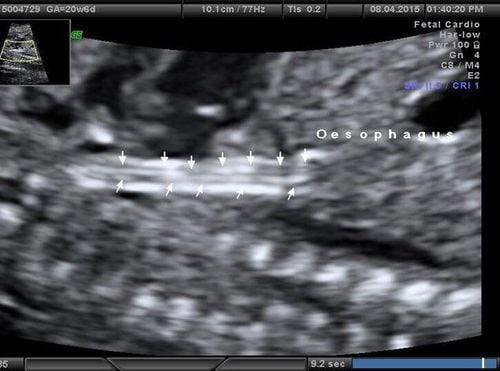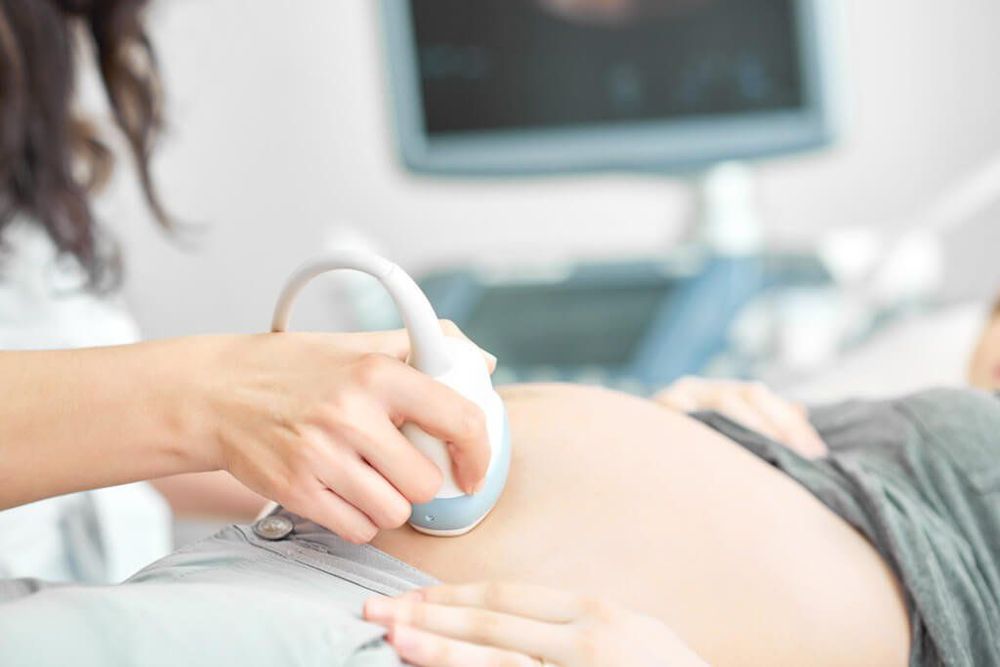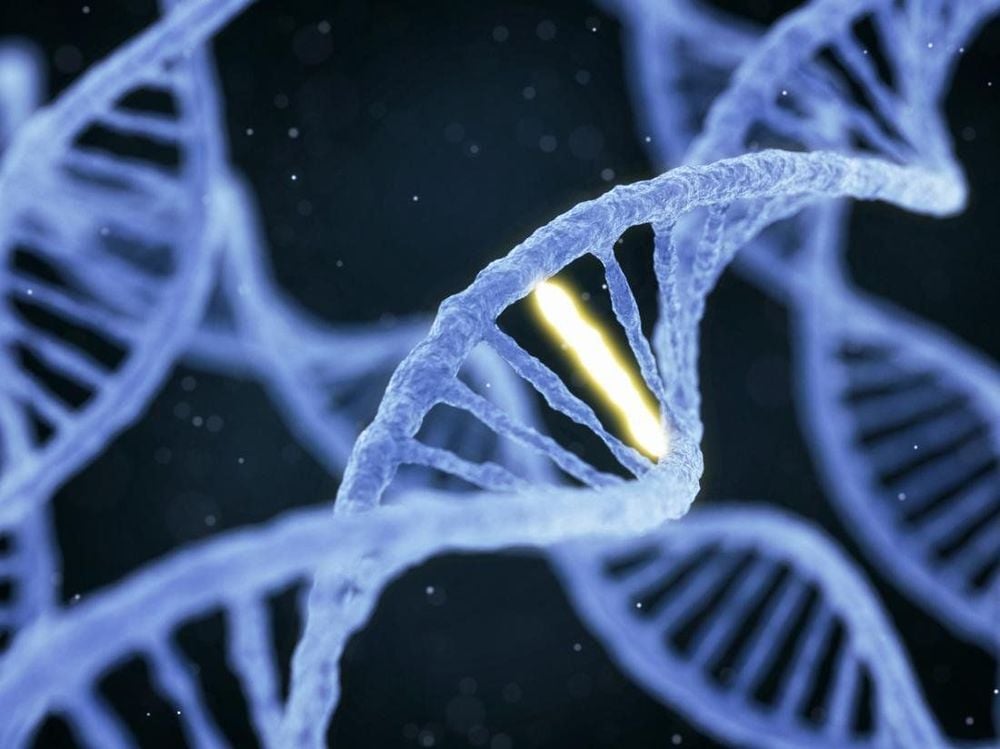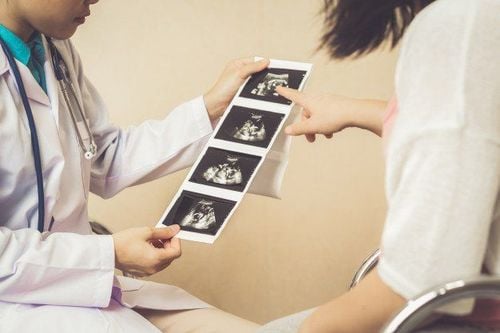This is an automatically translated article.
The article was professionally consulted by Master, Resident, Specialist I Trinh Le Hong Minh - Department of Diagnostic Imaging - Vinmec Central Park International General HospitalDigestive malformations are common malformations in the current literature. Most of these malformations need to be intervened immediately, otherwise there will be consequences for mother and baby. Early diagnosis of fetal malformations is extremely important for timely treatment. The following article gives us knowledge about gastrointestinal malformations in the fetus.
1. Overview
Gastrointestinal malformations in the fetus are common malformations. According to research, the rate of malformations in the digestive system accounts for 15% of all birth defects (DTBS). This disease has many risk factors from mother and child. Some studies have shown that the rate of gastrointestinal malformations in boys is higher than in girls and increases in children undergoing artificial insemination, mothers using certain drugs such as cocaine, thalidomide, smoking mothers, family economic hardship.
Gastrointestinal malformations if missed, delayed postpartum diagnosis, late indications for treatment, when there are complications, will affect treatment results, increased mortality risk and cause many complications, Poor recovery resistance affects development.
Prenatal ultrasound detected 34% gastrointestinal anomalies. Currently, there are many advances in the field of prenatal diagnosis, neonatal resuscitation, and surgical surgery. When the function is adversely affected such as congenital colonic aneurysm, anorectal malformation, it should be monitored and indicated for treatment.
2. The formation of malformations of the digestive tract during the embryonic period
2.1. Esophageal malformations Esophageal atrophy: Due to deviation of the tracheoesophageal septum during the division between the trachea and the esophagus of the anterior intestine; when the esophageal lumen in the process of esophageal lumen formation is incompletely formed; Abnormalities of tissues in the esophageal wall such as the esophageal ring, which resemble tissues of the airways containing cartilage and villi epithelium, are generally found in the lower third of the esophagus. There are many opinions on the distal esophagus: Due to the development of cysts occurring during the formation of the spinal cord at 18-19 days before the development of the anterior intestine begins, due to the duplication of the oesophagus. tracheoesophageal septum, due to the self-made wall in the esophagus.
2.2. Gastric malformations Small stomachs are rare because the anterior segment of the intestine is abnormal or restricted. Usually associated with an abnormally rotated esophagus and stomach, and possibly with an abnormal gastrointestinal tract. Gastric occlusion malformations may be due to incomplete lumen, diaphragmatic abnormalities, or stroke of blood vessels. pyloric stenosis hypertrophy : The pylorus muscle is enlarged, especially the sphincter, there are symptoms 1 to 2 weeks after birth and it doesn't happen before 4-5 days, this is considered an abnormality. natural. Stomach bifurcation: due to abnormal division of endoderm and spinal cord, and due to incomplete luminalization of cysts. Twisted stomach
2.3. Duodenal Obstruction When tube formation is abnormal and bowel rotation is abnormal.
Organs such as pancreas, portal vein, superior mesenteric artery are malformed.
2.4. Intestinal obstruction and atrophy Due to the regeneration of the lumen, the endodermal epithelium of the gastrointestinal tract from the stomach down becomes a simple columnar epithelium. Intestinal obstruction occurred at the site of the interstitial node and did not resolve. The researcher suggested that intestinal obstruction may have occurred due to complications of the mesenteric vessels. * Abnormal bowel rotation is the result of abnormal rotation and fixation of the intestine.
* Meconium intestinal obstruction: Due to pancreatic insufficiency, due to increased mucus secretion by the glands in the intestines....
2.5. Meconium peritonitis When there is damage to the blood vessels to the intestine and because of the obstruction of the intestine, the intestines perforate and the meconium enters the abdomen causing peritonitis.
2.6. Digestive tract due to embryonic diverticulum not working because of normal regress. Due to adhesion between the endoderm and inner lining structures. Because a number of vacuoles do not clump together at 6-7 weeks gestation, to create a single void. 2.7. Congenital megacolon Due to the cells of the neural crest traveling from the upper part of the gastrointestinal tract stop migrating to the lower end of the GI tract in the developing fetus at 5-12 weeks. Normally the fetus develops at 6 weeks of pregnancy. cells of the neural crest go to the stomach, the developing fetus at 7 weeks goes to the small intestine, the developing fetus at 8 weeks goes to the large intestine, and the developing fetus at 12 weeks goes to the rectum.

2.8. Abnormal development of the hindgut No anus: when the anus membrane does not perforate at the 9th week, it causes malformations. Rectal atrophy due to vascular accident that feeds the rectum. Tourneux and Rathke folds cause anorectal malformations from 4-6 weeks of gestation. 2.9. Umbilical fistula Due to the existence of the umbilical cord. The umbilical cord is the connection between the small intestine and the umbilical sac during fetal life. From 5-7 weeks gestation, it will gradually regress and disappear completely.
2.10. Short bowel syndrome Rare, etiology unknown. Some researchers suggest that during bowel lengthening, movement, and intubation are interrupted or delayed due to the lack of space between the developing alimentary canal and the umbilical cavity. Or due to a lack of enteric neurodevelopment.
3. Causes of birth defects in the fetus
Due to genetic factors 20%, due to chromosomal abnormalities 5 - 10%, due to viruses 5 - 10%, 60% of unknown causes are attributed to multiple factors.
3.1. Genetic factors Due to single gene mutations and chromosomal mutations. Gene mutations account for only about 50% of cases. 3.2. Environmental factors * Physical agents
Radioactive substances directly affect the embryo causing cell death. Indirect effects on sex cells, causing mutations in chromosomes, thus causing birth defects in the next generation. X-rays, gamma rays, and ultraviolet rays can also cause disorders in the morphological development of embryonic organs.
* Chemical substances
During the war, in production and business, chemicals are used to cause birth defects, birth defects and other reproductive events such as miscarriage, stillbirth. In the case of VACTERL syndrome, the mother had very high lead levels in the first 3 months of pregnancy.
* Biological agents
Through the placental barrier, the embryo can be infected with some bacteria, viruses and protozoa from the mother, leading to the embryo suffering from some diseases like the mother's. When the concentration of bacterial and viral toxins is too strong, the embryo will surely die.
3.3. Other causes in parents and some related factors Increasing maternal age increases the risk of fetal abnormalities, usually chromosomal abnormalities. The mother's body is still young, the body is not perfect, the hormone is not balanced, affecting the normal development of the fetus, thus also causing birth defects.
3.4. Multifactorial Genetic Causes Birth defects that are caused by genetic factors are multifactorial and have a combination of genetic and environmental causes and are familial.

4. Ultrasound diagnosis of fetal anomalies
Currently, ultrasound is a commonly used imaging method, with high results in detecting abnormalities in shape, without affecting fetal development.
4.1. Diagnosis of polyhydramnios is divided into 3 levels based on:
Amniotic fluid angle at the deepest level: from 8-11cm is mild, from 12-15cm is moderate and severe is over 16cm. Amniotic index (AFI): Mild from 25 - 30 cm, moderate from 30.1 - 35 cm, severe over 35.1 cm. 4.2. Diagnosis of esophageal atrophy Direct image: sac of the esophagus above the obstruction; often observed in fetus after 25 weeks of age, related to signs of regurgitation of the fetus. Indirect imaging shows no stomach or small stomach on ultrasound. Normally, the stomach can be detected at 14-15 weeks of gestation. 4.3. Diagnosis of duodenal obstruction Double balloon image due to the tip above the duodenal obstruction and due to gastric dilatation. This image can be observed when the fetus is developing at 12 weeks, for a clear diagnosis when the fetus is developing at 7-8 months.
4.4. Diagnosis of intestinal obstruction Normally, the colon can be dilated up to 18mm in the case of a full-term infant.
Small bowel obstruction: The image shows dilated loops of bowel forming non-echoic circles greater than 7mm in diameter and greater than 15mm in length, with visible antiperistaltic waves, 100% small bowel dilatation in fetuses. after 20 weeks. Large bowel obstruction: Dilated colon greater than 20 mm in diameter; at 25 weeks of pregnancy ultrasound can be observed 100% of the intestinal loops dilated throughout the abdomen seen in Hirschsprung disease. 4.5. Diagnosis of abnormal bowel rotation Ultrasound shows a wide, coffee bean shape, thick wall without peristalsis, with many smaller and less dilated bowel loops lying around.
Color Doppler ultrasonography can show a "whirlpool sign" due to twisting of the superior mesenteric vein around the superior mesenteric artery. This is a valuable sign for the best definitive diagnosis.
4.6. Diagnosis of meconium peritonitis is divided into three types:
Type 1: Large meconium ascites: Meconium forms a non-echoic region (ascites); signs of calcification of areas with inflammatory reactions, areas of increased echogenicity in the abdomen; Dilated bowel loops, thick wall. Type 2: Large cyst formation: calcification forms dense, sac-shaped echoes, limiting the echogenic region of the inner meconium. Type 3: Calcification or production of small pseudomeconium cysts. 4.7. Diagnosis of anal malformation No anus: Calcification of the intestine, no anal ring. Normally, the anal ring can be seen as early as 15 weeks pregnant and clearly in the third trimester of pregnancy. The first 3 months are the most sensitive time during pregnancy. In order for mother and baby to be healthy, parents need to pay attention to:
Understand early signs of pregnancy, pregnancy poisoning, bleeding during pregnancy. Timely, correct and sufficient first prenatal check-up, avoiding too early/too late. Fetal malformation screening at 12 weeks detects dangerous fetal malformations that can be intervened early. Distinguish between normal vaginal bleeding and pathological vaginal bleeding for timely intervention to maintain pregnancy. Screening for thyroid disease in the first 3 months of pregnancy avoids dangerous risks before and during delivery.

Vinmec currently has many maternity packages (12-27-36 weeks), in which the 12-week maternity package helps monitor the health of mother and baby right from the beginning of pregnancy, early detection and timely intervention. health problems. In addition to the usual services, the maternity monitoring program from 12 weeks has special services that other maternity packages do not have such as: Double Test or Triple Test to screen for fetal malformations; Quantitative angiogenesis factor test for preeclampsia; thyroid screening test; Rubella test; Testing for parasites transmitted from mother to child seriously affects the baby's brain and physical development after birth.
For more information about the 12-week maternity package and registration, you can contact the clinics and hospitals of Vinmec health system nationwide.
Please dial HOTLINE for more information or register for an appointment HERE. Download MyVinmec app to make appointments faster and to manage your bookings easily.














